Take a look at our New Arrivals: a variety of selections now available!
When buying Tanzanite jewelry online, you may be limited from a physical inspection of the gemstone. However, there are ways that can help you pick the right one for you. The first thing you need to know is that not all blue gemstones are Tanzanite.
Tanzanite is believed to have been formed about 585 million years ago but was only discovered by Manuel de Souza in the Mererani Hills of the Manyara Region in Northern Tanzania in 1967.
In its natural state, zoisite is rarely blue. The blue color of zoisite is produced by the minerals of Vanadium in its lattice and is achieved by heat-treating the brown zoisite to a temperature of 600 degrees Celsius for about 30 minutes. That is 6 times the temperature of boiling water!
Did you think 600 degrees Celsius is a lot of heat? Hold that thought! Compared to other gems such as rubies and sapphires, Tanzanite’s heat treatments are considered mild. Rubies and sapphires can be heated to temperatures between 1000 and 1800 degrees Celsius and the heat is sustained for days or weeks.
Tanzanite was used for commercial purposes in the 1960s. Within a short period of time, the stone gained popularity and became the second most popular blue gem after sapphire. Apart from its unique beauty and characteristics, people purchase Tanzanite because of its much lower price compared to other gems.
Tanzania is the only world-known source of rare blue gemstones. The gemstone was given its name by Tiffany & Co. who named it after its country of origin. To date, This blue gemstone can only be mined in the Mererani Hills near the foot of Mount Kilimanjaro.
The answer is no. Customers are advised to be careful when buying Tanzanite Jewelry online as there are other blue gems in the commercial markets. Color alone should not be a determining factor as there are other blue gemstones including aquamarine, topaz, and sapphire.
On top of that, experts in gemstones have come up with the Four C’s used for the grading of most gemstones. Be sure to request information on the gemstone from the seller so you can check if they fit the criteria of the Four Cs.
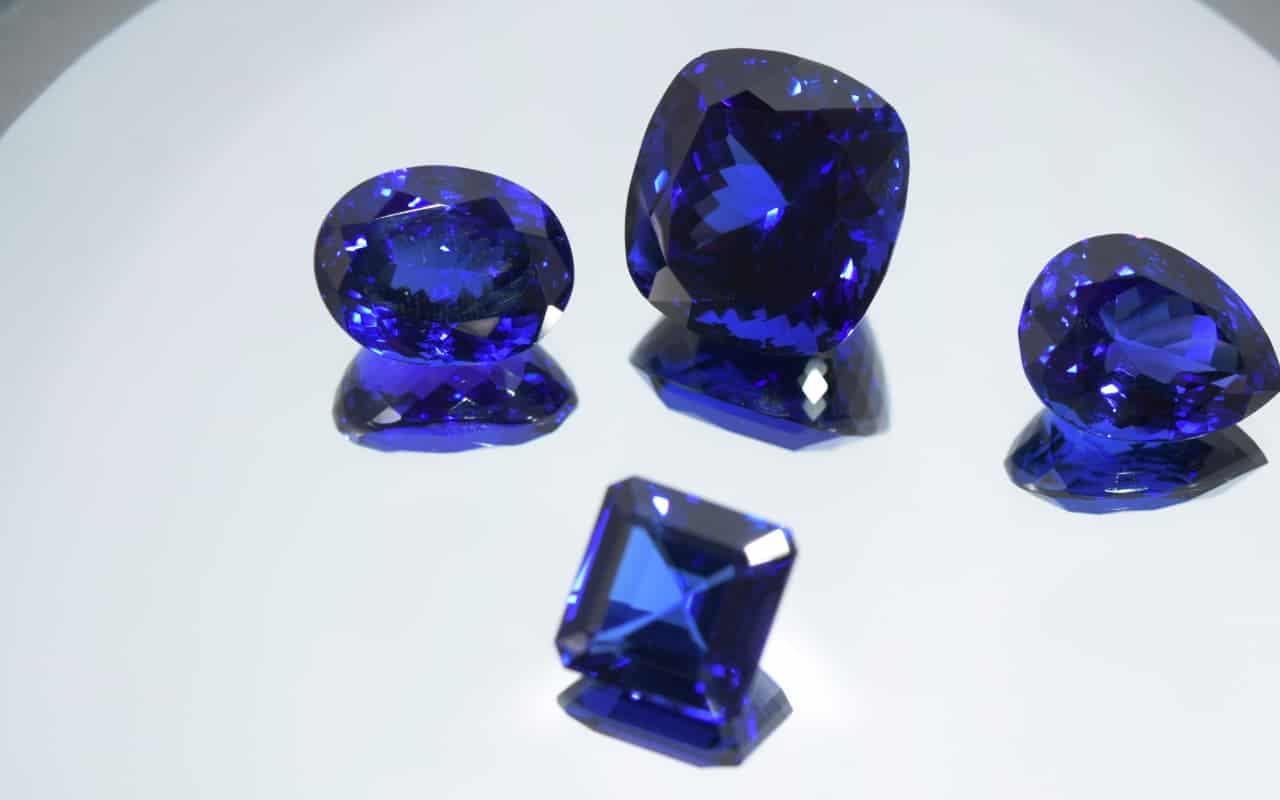
Color refers to the hue of the stone and the degree of color saturation. Unlike diamonds, color in Tanzanites is the most significant feature. The blue in a Tanzanite is valued in terms of hue, tone, and saturation. Clear, deep blue-violet Tanzanites are valued more than dusty ones same to Tanzanite Jewelry.
Tanzanite is a pleochroic gem, which means that it can seem to have different colors when viewed from different angles. It obtains its blue color as a result of heat treatment, which reveals Tanzanite’s pleochroic blue and violet colors. Heat treatment can occur naturally through the natural-heating process within the earth before the gem is mined.
Only a small amount of Tanzanite has a naturally produced blue color through the heat of the metamorphism. These naturally blue gems are more valuable and held in high regard by both gemstone buyers and sellers.
Tanzanite can also be man-heated which is a recognized practice in order to achieve the famous blue color of the gem.
Determining whether Tanzanite has been heated or not is a challenging task. Most professionals are also under the assumption that the majority of these gemstones in the world have been heated in one way or another.
An honest seller will disclose if the gem has been heat-treated. Heat treatment has a significant effect on the stone's value but won’t depreciate its quality.
As with most colored gemstones, the deeper the color, the higher the value. Untreated Tanzanite is typically brownish in color, and while they are not considered to be the best, many people who prefer softer colors will gladly purchase them.
A gemstone clarity refers to the number of inclusions or flaws found in the stone. Inclusions and/or flaws occur naturally and have an effect on the value of gemstones. A gemstone with less or no inclusions has more value as compared to one with inclusions and/or flaws.
Like Diamond, the clarity of Tanzanite is graded ranging from Internally Flawless (IF) to Included. Below are the known clarity grades:
Think of inclusions as wanna-be-cracks in a gemstone. They put the gem at risk of developing cracks and eventually resulting in breakage. This can lower the value of a gemstone greatly. It is only logical that high-rated gemstones with higher or perfect clarity are rarer and more valuable.
For Tanzanite and other colored gemstones, unlike diamonds, the concern is mostly placed on whether the inclusions are visible to the naked eye. There is less regard for the number of inclusions visible under the scope.
The Gemological Institute of America (GIA), classifies Tanzanite as a Type I gemstone, which means it is usually flawless to the naked eye. This means that a Tanzanite with flaws visible to the eye is quite rare to find and will be lower in value. Most of the gemstones sold for jewelry have inclusions that can only be seen under magnification
The Cut refers to how the gemstone has been shaped to optimize its beauty. Cutting has an effect on what color the consumer will see afterward.
This makes cutting a thorough and precise procedure as it may affect the color, fire, and beauty of the product.
Deciding how to cut a Tanzanite is making a financial decision by itself. A cut has an impact on color, and some weight might be lost in the process. Those two factors are considerable factors in determining the value of Tanzanite.
Cuts to achieve a violet-purplish color wastes less weight as compared to cutting aiming for a violet-blueish color. This is why violet-purple Tanzanites are more readily available than those with a stronger blue color.
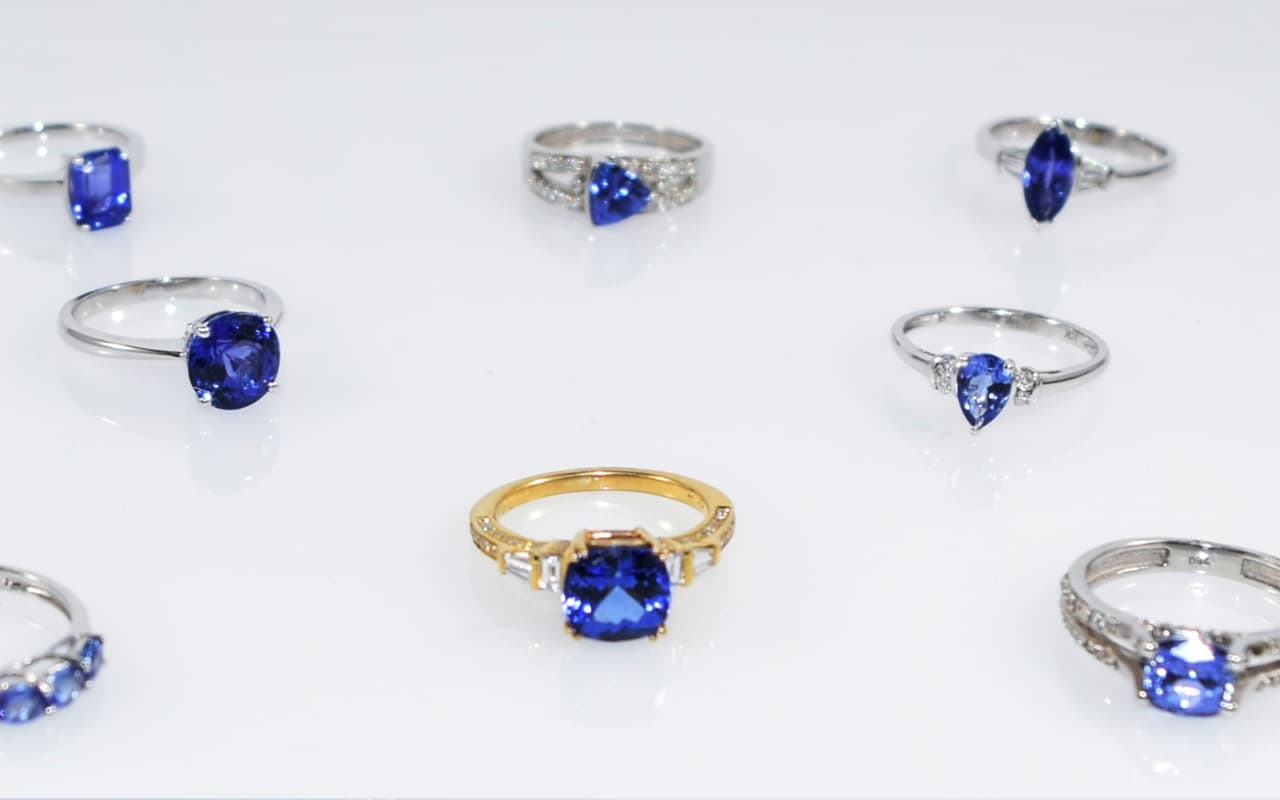
Tanzanite is measured in terms of Carat Weight. One carat has 100 points and weighs 1/5 of a gram. Naturally the higher the carat, the higher the cost. If a Tanzanite is larger in size and its colors and clarity are optimum, its value grows even further.
The weight of Tanzanite stones varies depending on the stone’s depth. “Face up” measurements (length x width) are the best way to measure a Tanzanite’s visual size.
Tanzanite is available in a wide variety of sizes. The finest and deepest colors are usually seen in sizes over 5 carats. Smaller stones are often less intense in color. For instance, if you have two stones of equal saturation, the larger one will have a richer color.
Smaller stones are more available than larger Tanzanites. The most common faceted Tanzanites are under five carats and are widely used in commercial jewelry. The stones over fifty carats are available but rare and those with top-color grade often end up in custom or designer jewelry.
Tanzanite can be bought as a single stone or as jewelry. The choice is yours. The advantage of buying loose stones is that you have more freedom of buying sets of stones that you can use to create matching jewelry. You could also keep the stones as an investment due to their predicted scarcity in the next decades.
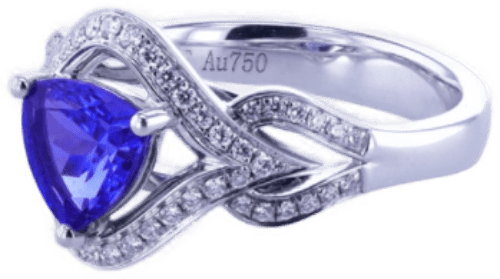
While tanzanite is undoubtedly beautiful, it can also be very delicate and not suitable for all uses. Tanzanite is best used in jewelry items that will not encounter abrasion and impact such as earrings and pendants. Tanzanites may not be suited for rings especially if you intend to wear the ring on a daily basis. It may be best to save the ring for special occasions so as to reduce abrasion and impact. You are also advised to select jewelry whose design is set to protect the stone.
Tanzanite is no exception to imitations. A few manufactured materials such as synthetic forsterite (a mineral in the olivine solid solution series) have a similar appearance to tanzanite. Others include Coranite; synthetic blue corundum, Tanavyte; a purple yttrium aluminum garnet and some blue glass has also been used as a tanzanite imitation.
Imitation materials cannot legally be sold as "tanzanite." They must be labeled in a way that gives the buyer a clear understanding that the item being purchased is not natural tanzanite but only "looks like tanzanite."
Luckily, there aren’t any synthetic Tanzanites (yet). Seeing how the world will be short of Tanzanite in a few years, it is only expected that someone will figure out a way to make Synthetic Tanzanite. When we get to that stage, you may want to check if you are getting an original Tanzanite or a synthetic one.
Some coatings of cobalt have been applied to some pale-colored Tanzanites to improve their color. An experienced jeweler should be able to recognize coated Tanzanite and inform the buyer accordingly. However, you shouldn’t take chances why your purchase and add a coating to your list of questions to the seller.
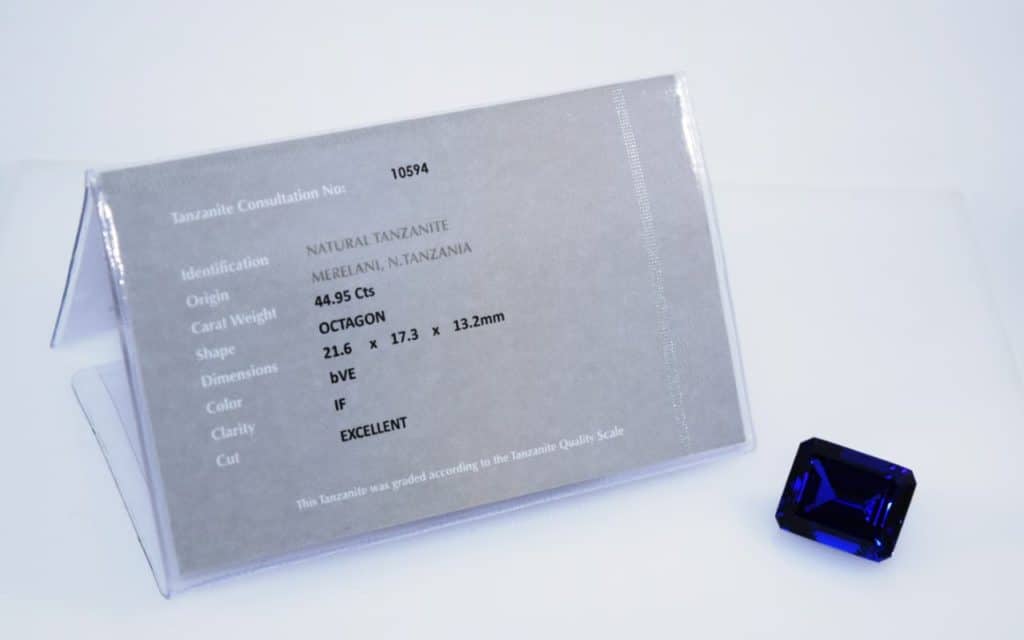
Unless you are looking to buy an heirloom a.k.a a secondhand Tanzanite, ask for Tanzanite whose origin is Tanzania. Well, this should be simple, given that the only source of Tanzanite is Tanzania.
This is important when buying tanzanite jewelry online. Be sure to check the return policy in case the stone delivered to you looks nothing like what you saw online
Metal preference can also affect the cost. Usually, 10K gold is lower priced than Metal preference can also affect the cost. Usually, 10K gold is lower priced than 18K gold, both yellow gold finish, as well as white gold. The color of tanzanite is always enhanced by white gold. If you are choosing Tanzanite and diamond jewelry, choose diamonds of lower color and tip the costs. Such small diamonds don’t need certification necessarily.
If you prefer Tanzanite jewelry over loose stones, a great way is to customize your design online. Most sites offer to customize jewelry, and you can if you prefer Tanzanite jewelry over loose stones, a great way is to customize your design online. Most sites offer to customize jewelry, and you can choose the tanzanite and its accompanying gold/diamond according to your budget.
Known to evoke clarity, heartfelt communications, and focus, blue gemstones have taken over the world with their vibrant shades. From turquoise and sky to royal blues and violets, there’s a gem for everyone. Here’s a glimpse at 13 of the most appealing gems.
Tanzanite is one of the rarest and most beautiful gems in the world. Found solely at the foothills of Mount Kilimanjaro, Tanzanite is a token of Tanzania’s rich history and heritage. It holds vibrant tones of blue, ranging from the sky to royal to transcendent blue, and warm indigos.
Another significant appeal of Tanzanite is its rarity. Being a thousand times rarer than diamonds, Tanzanite is an inescapable collection piece for your jewelry box and your persona.
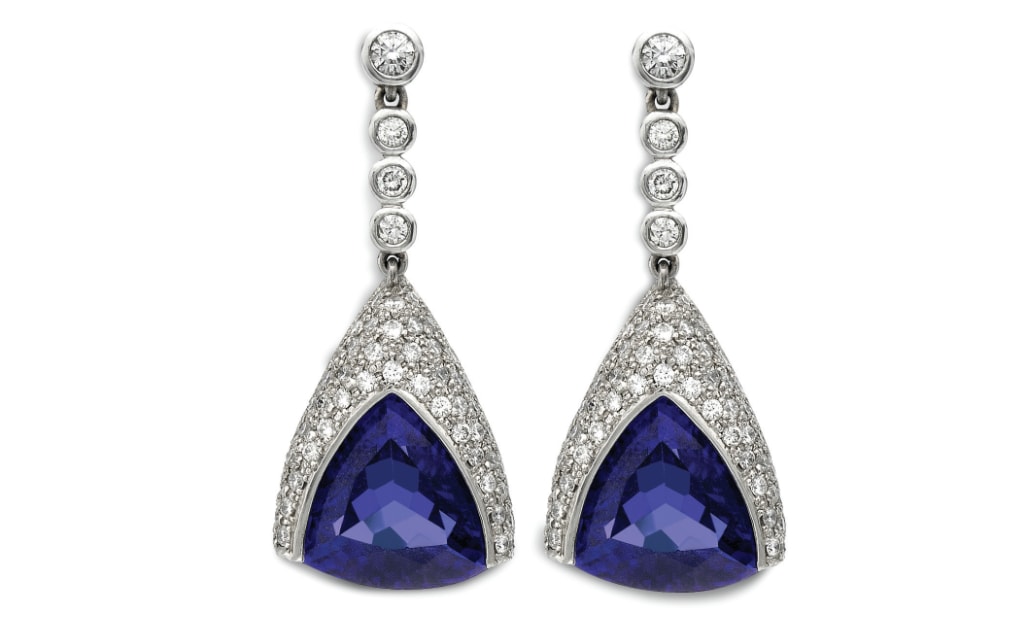
These gemstones are also among the rarest gems used for jewelry. These diamonds are known for their durability and their range of blues, ranging from light, greyish to dark. These factors make it a common but very expensive choice for jewelry.
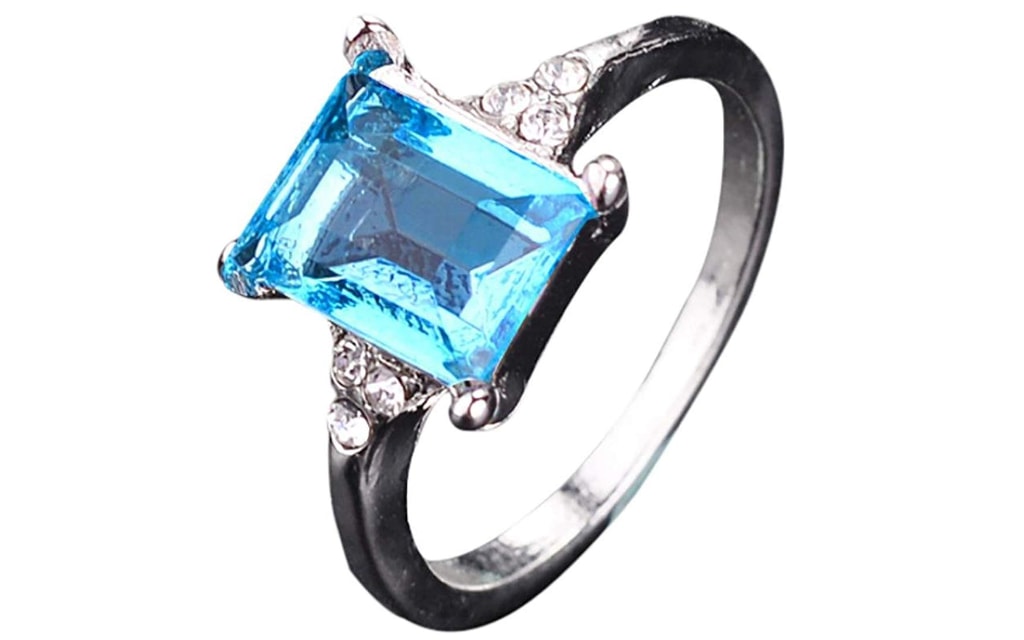
Sapphires are probably the most commonly known of the gems. The rough stone is often treated by jewelers to obtain greater clarity and alter the color of the gemstone. Sapphires are very common due to their durability and color.
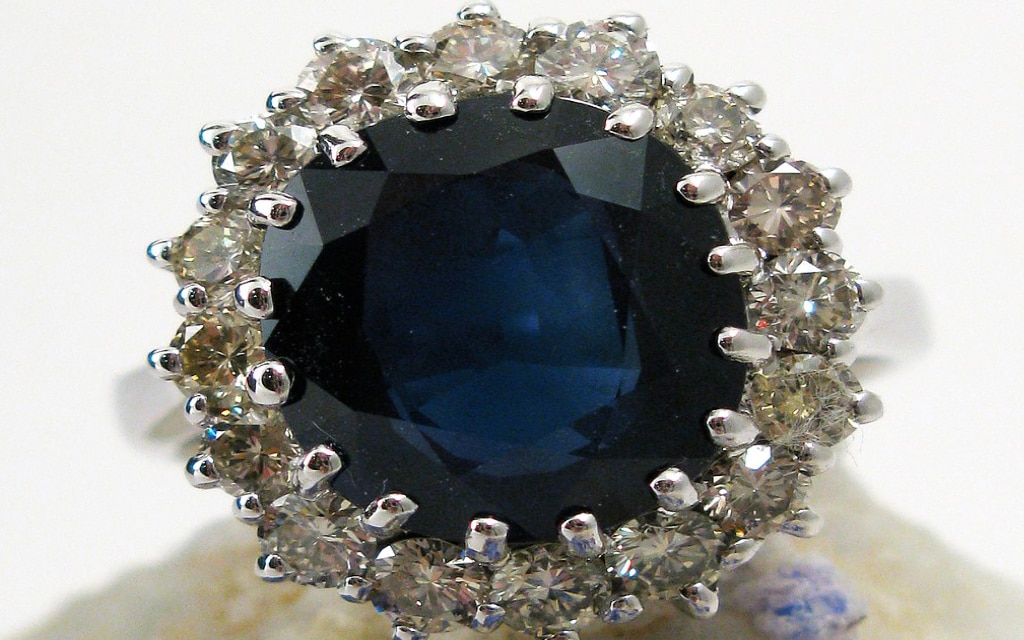
Aquamarine is one of the blue gemstones with the lightest shade. Acquiring its name from the sea color, Aquamarine has varying shades of pale blue, turquoise, and sometimes spring blueish-green. It is a gem of high transparency and thermally enhanced coloring.
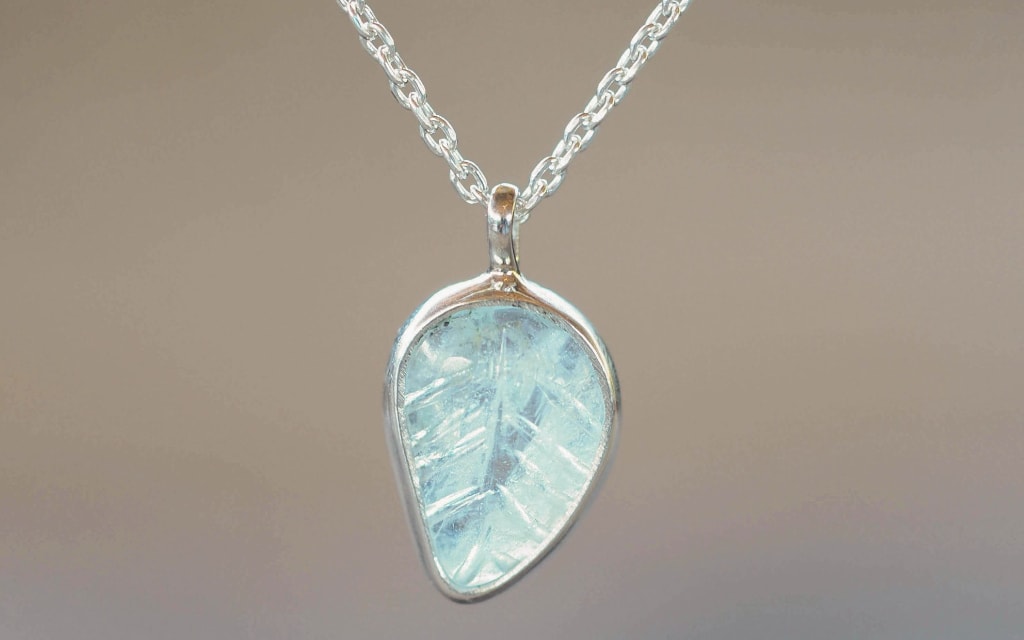
Once again, heat treatment creates the famous transparency and color of this gemstone. The gem is relatively affordable due to its common products on the market, unfortunately decreasing its intangible value.


This gemstone has high versatility. The shade of the stones may vary and depends on the concentration of minerals present.
The bluestone is often sold mixed with the green one for jewelry. Blue Tourmaline is also thought to offer many physical, spiritual, and mental benefits for the person wearing it. However, stones larger than 1 carat are very rare and expensive.
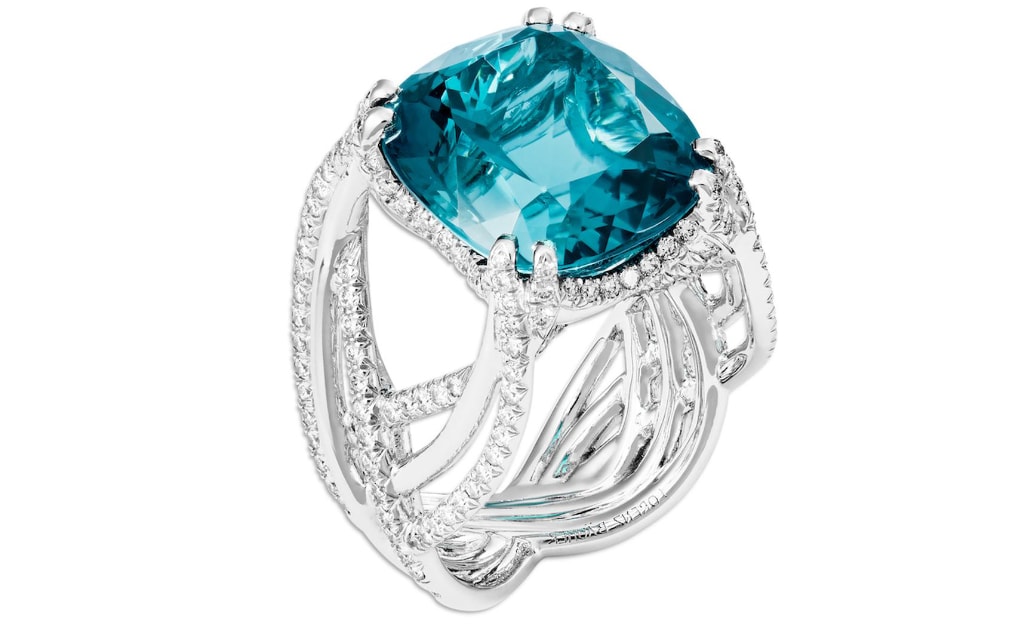
This gemstone has become increasingly popular on the market due to its resemblance to blue diamonds and its affordable price. However, its sparkle is known to fade relatively quickly. The stone is also known for being brittle and has a high risk of chipping.

Turquoise holds its name from its vibrant blue-green color. The opaque stone is often found with golden brown spottings and highlights. It is relatively affordable and available in abundance.+

Iolites are similar to Sapphires, beautiful gemstones in various shades of blue and purple. However, its high availability reduces its collectible value on the market. Lolites are relatively durable and affordable for all types of jewelry.
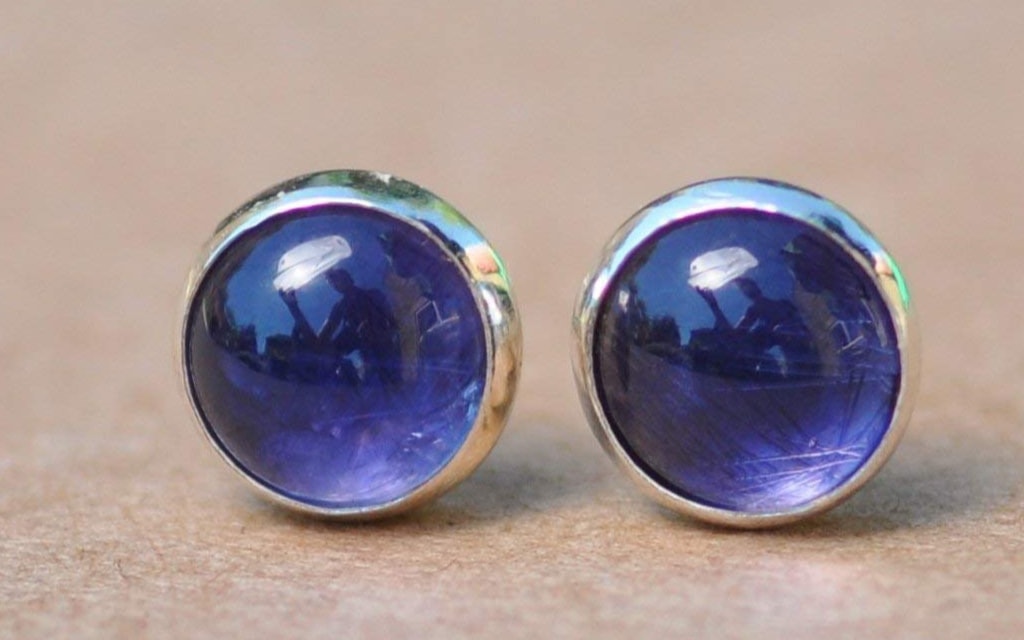
Lapis Lazuli is an opaque royal blue gemstone. It is often infused with golden or white highlights for more intricate designs. The mesmerizing color of the Lapis Lazuli, along with its accessibility and affordable price, makes it a well-known stone among amateurs.
However, the softness of the gem makes it vulnerable to scratches and a significant loss in shine. Worn on multiple occasions, the Lapis Lazuli demands much care to remain in optimal condition.
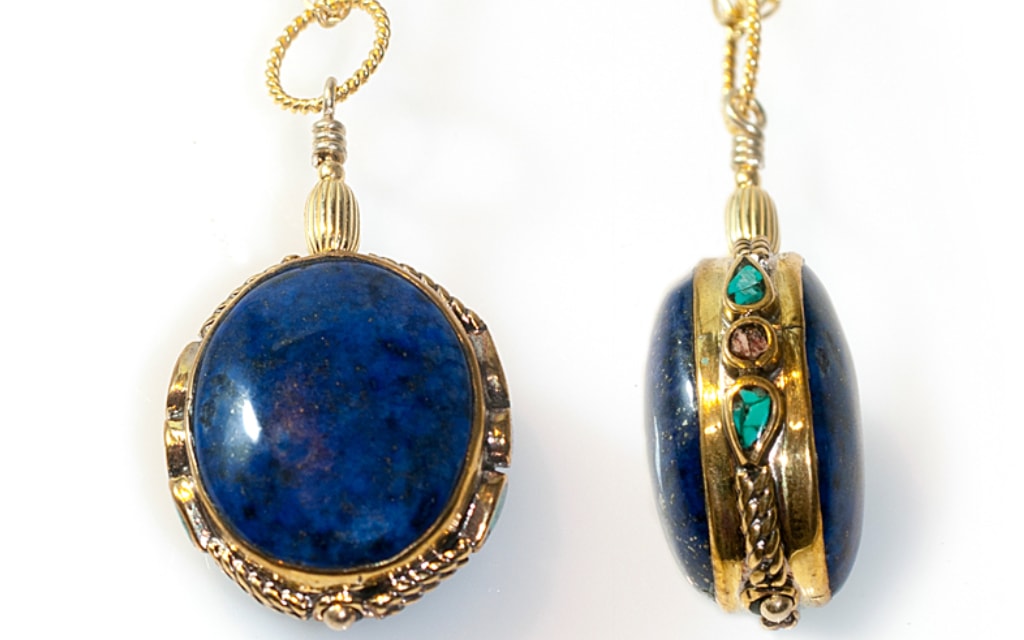
This gem holds its name from the optical effect, of Labradorescence. The colors are not present inside the stone but are a result of the reflection of light within, providing the changing colors of Labradorite. These iridescent colors can match any jewelry.
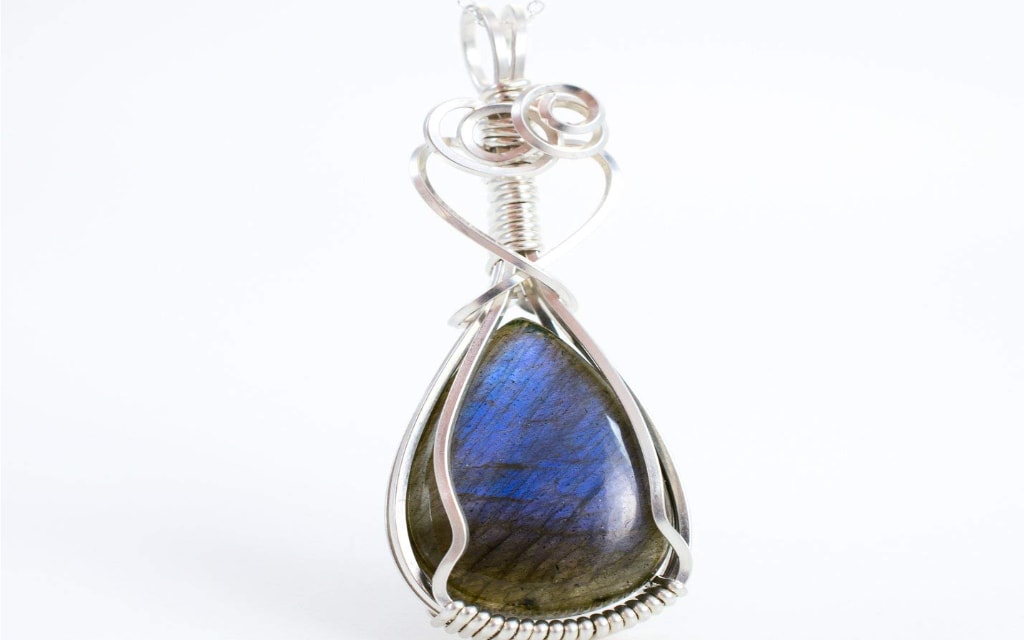
Azurite is another vibrant dark blue stone. The translucent stone turns into a cyan blue when exposed to light, and is relatively accessible. However, Azurite’s blue pigmentation is known to sometimes fade to green with the passing of time. Extra care is thus advised when wearing and storing the gem.
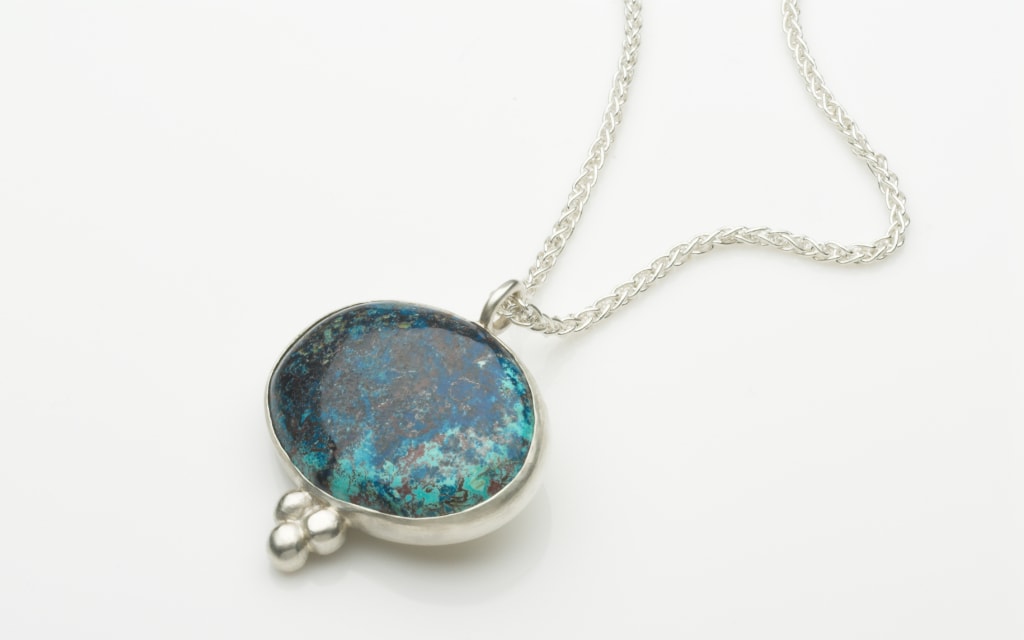
This is a fairly new stone in the blue gemstone arena. The teal-colored gem is extremely rare and thus, incredibly expensive. It is a unique stone with various mythical properties which is very collectible.
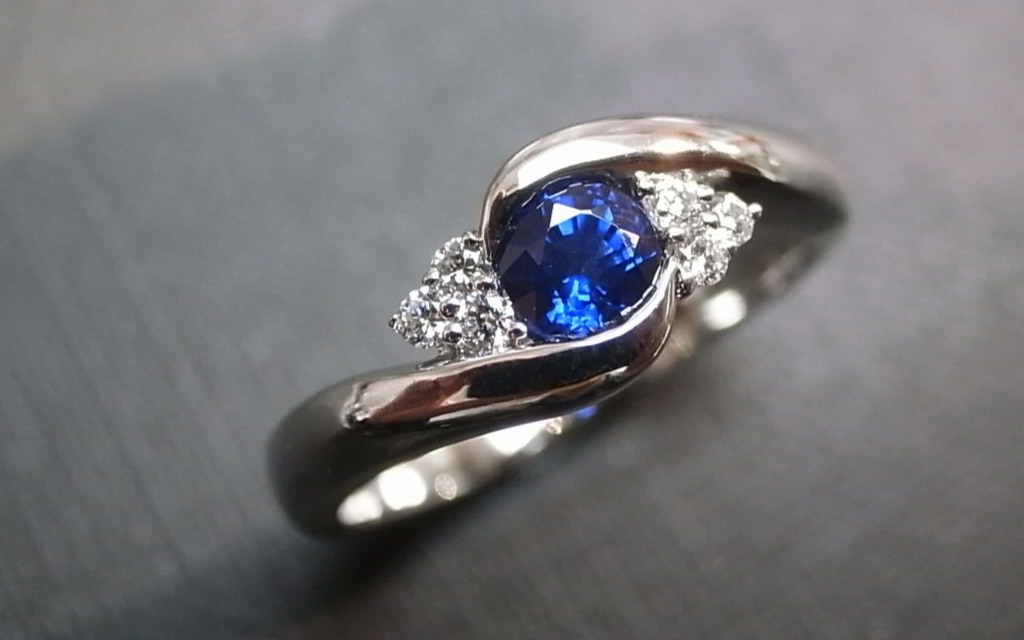
Tanzanite is one of the most mesmerizing gemstones in the world. Known by many for its protective powers, it is said to promote a healthy and prosperous life. Take a look at our displays and online store to find the perfect rare gemstones for you.
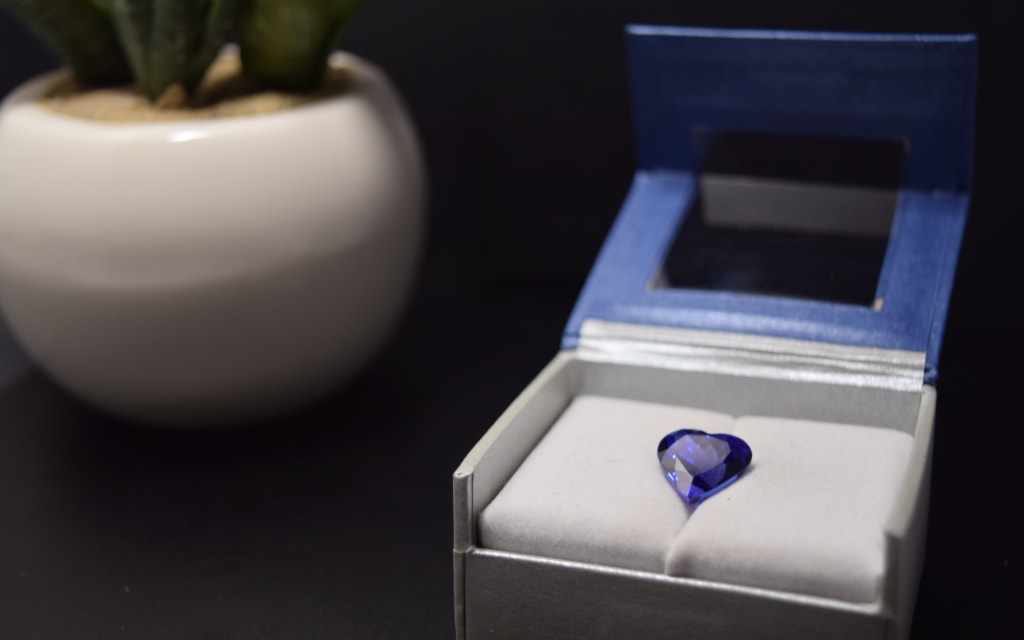
There are many places to visit in Arusha, but before we have a look at them, let's look at the city itself.
Arusha is located in Northern Tanzania and is famously known as the green city of Tanzania. Arusha is blessed with a lush and green environment, thanks to the relatively low temperatures and alleviated humidity.
Its relatively cool weather helps attract tourists from different parts of the world.
Apart from that, Arusha is also the hub for tourism in the northern circuit and we can dare say it is the hub for tourism in Tanzania as a whole.
Most safari trips start from Arusha as the city is the gateway to Kilimanjaro National Park, Tarangire National Park, Lake Manyara National Park, Ngorongoro Crater, Serengeti, and without forgetting our own Arusha National Park.
The city is not only a gateway to National parks, but there are also a lot of other attractions to visit in Arusha. Here are our top 10 places to visit in Arusha.

Miracle Experience is at the top of our list of attractions to visit in Arusha as it offers a different perspective on safaris. It quite literally provides you with a safari from the sky.
Hot air balloon rides over Serengeti National Park will give you an incredible safari experience with enchanting scenery and uninterrupted views for an unforgettable adventure. You will bear witness to a plethora of wild animals, from magnificent Wildebeest to lions and gazelles, in their natural habitat.
With hot air balloon safaris, you can appreciate the true magnitude of the Serengeti. The balloon safari provides you with a unique opportunity to capture captivating moments. As a testament to how great the experience is, Miracle Experience has been listed as one of the top 10 attractions to visit in Arusha.
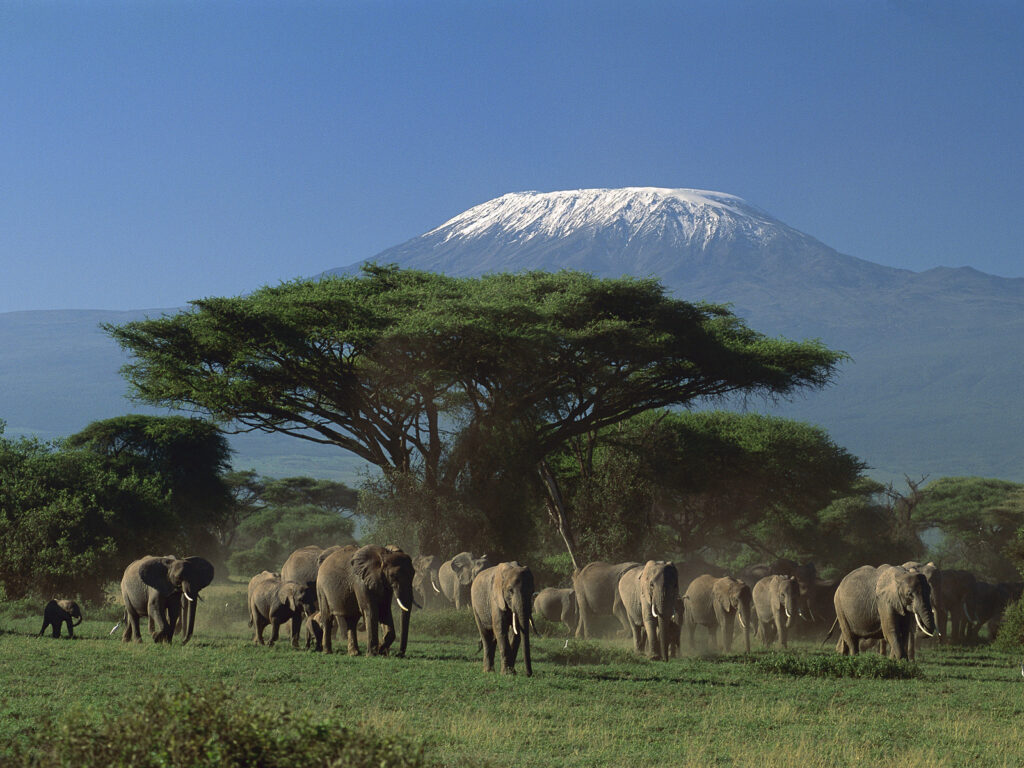
They say east or west, home is best. Before venturing into faraway places in search of attractions to visit, Arusha National Park is just a few kilometers away from the Arusha City Centre.
Arusha National Park can be visited as a day trip. The park encompasses Mt Meru, the Momella Lakes, Ngurdoto Crater, and the lush highland forests.
Game viewing in Arusha National Park is not what you might expect in the Serengeti. Some of the common species found in the park include the rare colobus monkeys, zebras, giraffes, and bushbucks among others.
Take a day trip to the Ngorongoro Crater, also located within Arusha National Park, whose rocky cliffs enclose a wide marshy floor for great views of herds of buffalo and warthog.
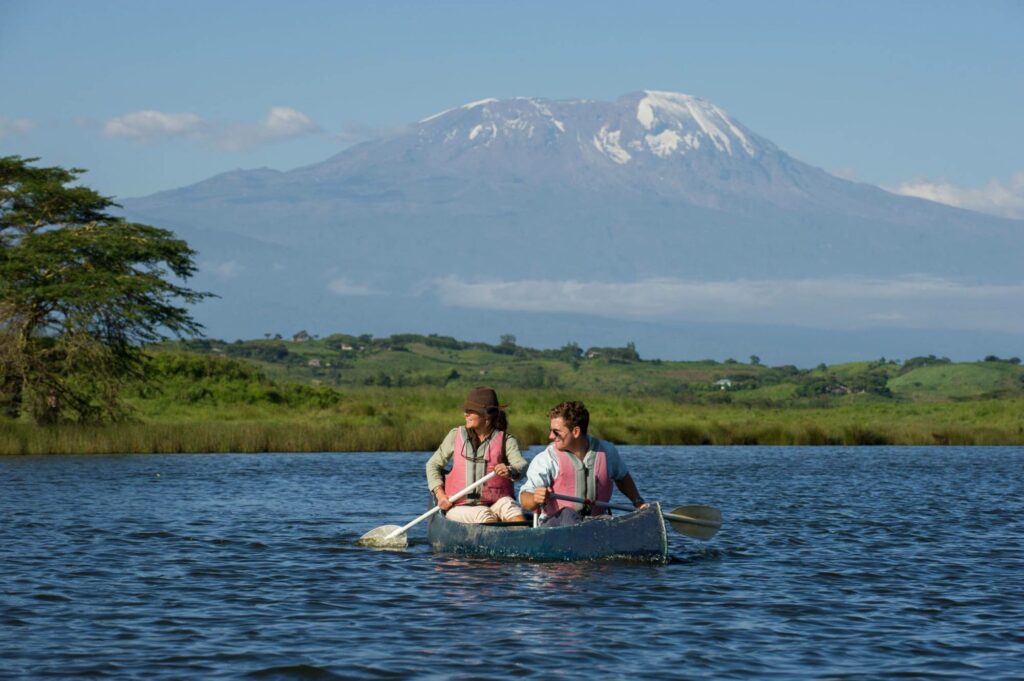
Not much of an attraction to visit, but a fantastic activity to do while in Arusha. Go on a canoeing trip in the Momella Lakes located within Arusha National Park. The lakes, with their hues of green or blue, are home to thousands of pink flamingos and waterfowl.
The canoeing trips are about 3 hours long and are best done in the mornings or afternoons. On a canoeing trip, you can expect to view buffaloes, bushbuck, giraffes, hippos, and many water birds living in and close to the water.

Mt. Meru trek is a “warm-up” trek for those planning to climb Mount Kilimanjaro. It is a great way to acclimatize in preparation for a climb on Africa's tallest mountain.
Mt. Meru is also a fun hike by itself, suitable for people with a few days on their holiday calendar, and still wishing to do mountain climbing. One can hike Mt. Meru as a day tour or as a full 3 or 4 days hike. The trails offer amazing views of rivers and waterfalls for a relaxing hike.
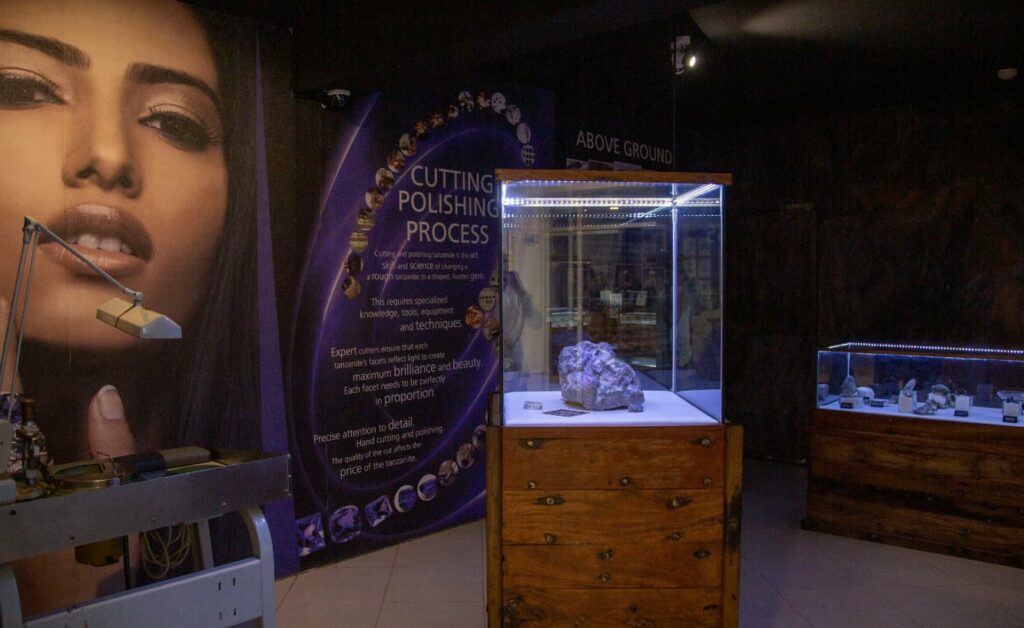
This list wouldn't be complete without talking about our own Museum. We boast the world’s only Tanzanite Museum located in Arusha.
The Tanzanite Experience Museum is a must-visit while you're in Arusha in order to learn more about the precious and rare Tanzanite stone whose only known source in the world is Tanzania, specifically in Arusha.

We offer interactive tours and visual exhibitions which include a replica of a Tanzanite mine shaft where you can discover how tanzanite was created, named, mined, cut, polished and graded.
Our museum is located in the center of Arusha and has a store attached to it. The Tanzanite Museum stocks a range of loose stones as well as exquisite Tanzanite jewelry available for purchase. There are also other store locations that you can visit.

Lake Duluti is a crater lake located near the town of Tengeru, 14 kilometers from Arusha city center. The lake is surrounded by the Duluti Forestry Reserve and has water throughout the year, mainly from groundwater and seasonal rainfall.
Lake Duluti covers an area of about 63 hectares and the crater walls are up to 200m high, mostly covered in thick forest.
The forest is a perfect environment for reptiles’ hunting and nesting. Common reptiles found around Lake Duluti include the green mamba and Monitor lizards. The lake also provides a perfect habitat for water birds such as grey herons, fish eagles, cormorants, ospreys, egrets, and kingfishers.
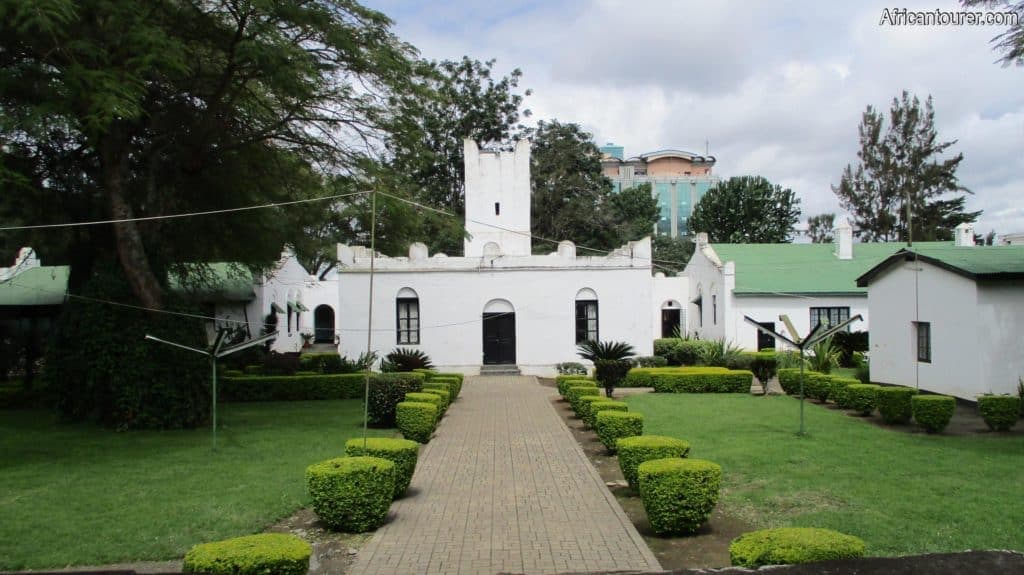
The Old Boma Museum is located within an old German Military Outpost. Today, the museum showcases the city’s history, wildlife, culture, and human evolution including findings from the famous Olduvai Gorge and the Laetoli sites. The best place to visit in Arusha if you're a history buff.
One can expect to learn about the evidence of human evolution, the history of Arusha during the German Colonial era, and photos of wildlife and mountains.
For art enthusiasts, one can take arts and crafts lessons including painting, and drum making. The museum also hosts a mini-serpentarium, a mini-zoo, a mini-botanical garden as well as a section for the study of insects.
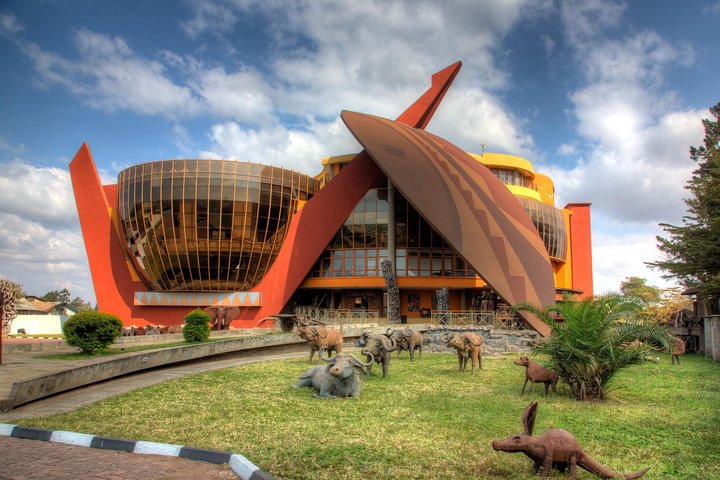
The Cultural Heritage Centre is located on the outskirts of Arusha. The center has a commercial art gallery, curio shops, and a jewelry boutique
At the cultural heritage center, you can purchase ornaments, jewelry, antiques, and local crafts depending on your budget. The arts and crafts showcase the present and past stories of the tribes of Tanzania.
You can also get a fresh meal at the center’s restaurant. Whether buffet or a la carte, the restaurant has a wide selection of meals including African dishes.
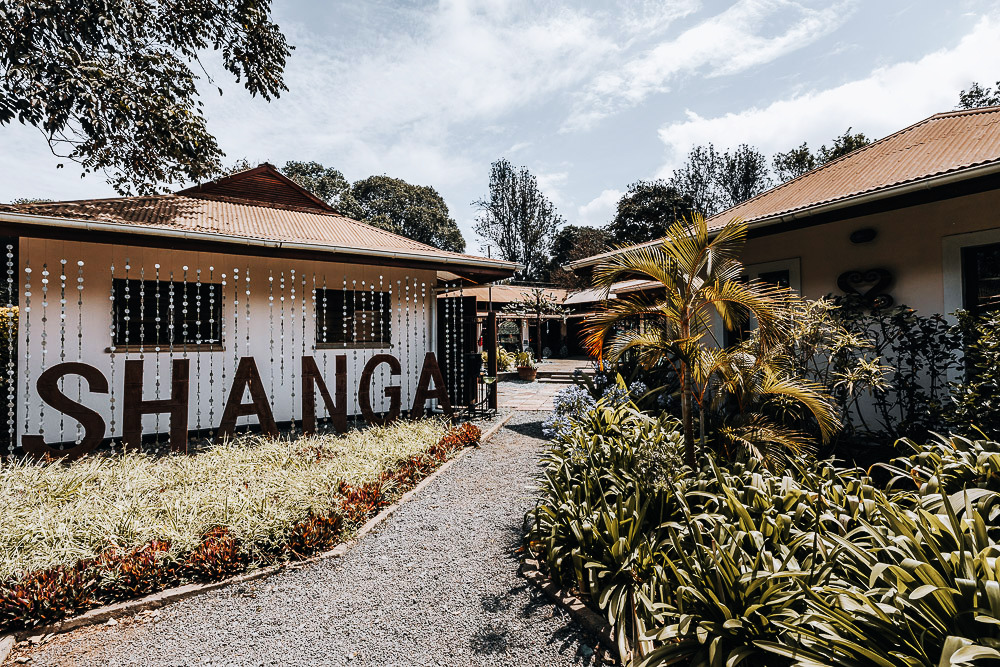
Shanga is a Swahili word for the bead(s).
It all started with a handful of local fabric and beads necklaces for a Christmas fair in Arusha that sold out within hours. Inspired by the need to generate extra income for people with disabilities, Shanga has grown to what it is today, employing over 60 people with disabilities.
They produce creative products including weaving, glass blowing, beading, papermaking, and metalwork, using recycled and sustainable materials wherever possible.
Shanga is located on the grounds of Elewana Arusha Coffee Lodge. A visit to Shanga will not only allow you to buy a piece of these amazing crafts but also support the efforts to empower people with disabilities.

If you are looking for some thrilling adventure, Meserani Snake Park is a must-visit. Located 25 km from Arusha town, the park offers guided tours on some of the most dangerous snakes in the world and if you are brave, a photo-op with a real-life snake.
Some of the snakes that you can expect to see are the Black and Green Mamba, Egyptian Cobra, Puff Adders, and many more. See the 3+ meter crocodiles at feeding time and get a chance to touch a baby crocodile.
Apart from snakes, you can also enjoy a tour of the Maasai Cultural Museum, and go on a safari to the local village on camelback.
The park also runs a free medical health clinic that serves the local community as well as a Free Education Centre for the local Maasai where they learn how to read and write and other opportunities to further their education.
After all the thrill, a barbeque meal at the fully equipped, and fully stocked bar is a perfect way to wrap your visit. you can also take a look at the Zanzibar travel guide
If you have gone through most of the attractions to visit in Arusha, you can venture slightly out of the region and go on game drives in Lake Manyara National Park or Tarangire National Park; both can be done as day trips from Arusha or from Arusha en-route to other destinations such as the Ngorongoro Crater and Serengeti National Park.
Before we jump into how you can read a Tanzanite certificate, here are a few facts about this blue gemstone.
Tanzanite as a name was first used by Tiffany and Company in reference to the Blue Zoisite mineral that was discovered in Tanzania in 1967.
Tanzania being the only known source of the stone in the world makes it a very rare gem. It is only fair to assume that there may be gem imitations in the market as the popularity of this gemstone continues to grow in demand while the supply remains constant.
A study conducted in 2012 showed that there was only about 30 years' worth of supply remaining in the ground.

To ensure one is paying for the right piece, a Tanzanite Certificate of Authenticity comes in handy when buying the rare blue gemstone. This certificate is essential in confirming the authenticity, characteristics, and provenance of your gemstone.
It’s important to have knowledge of some of the terminologies that you will find in a Certificate. A professional and honest jeweler will give you a certificate and will go through the details with you. He/she will explain what the specifications in your certificate mean in relation to the global grading standard.
With that said, the information he will give you at the time of purchase may be too much to absorb within a short period of time. You are advised to familiarize yourself with the specifications on your Certificate prior to making a purchase. It will be easier to understand your certificate if you have gone through some of the technical languages beforehand.
To create a grading benchmark, the Tanzanite Foundation introduced a color grading system that is now used by sellers and buyers worldwide. The Tanzanite Foundation is a non-profit organization that helps in the education of consumers about this rare blue gemstone. Understanding the color grading system will help you decode the information printed on the certificate to make an informed buying decision.

In addition to color grading, it is also important to understand other factors that make up the 4Cs. The 4C’s i.e Color, Carat, Cut and Clarity play an important role in determining the value of the gemstone that you are looking at buying. Read our guide to buying Tanzanite online that explains in detail the 4C’s and how they can affect your buying decision.
Once you understand this concept, you will be perfectly positioned to understand where your Tanzanite of choice falls under the global grading system.
Your certificate will indicate a number assigned to your stone. Each stone has its own unique number that can be used to trace the stone’s origin, ethical background, and authenticity.
Being rare, with a single known source of Tanzanite in the world, Tanzanite has become vulnerable to unethical mining and unethical routes to market. Ethical mining means that the Tanzanite has been mined in a controlled environment, under safe conditions for the miners, with fair working practices, and has followed an ethical route to market.
The certificate is a confirmation that the piece of gemstone that you will be buying has been mined in adherence to the Tucson Tanzanite Protocol, Labor, and Human Rights laws.

Not to be mistaken with the Cut, the shape of Tanzanite refers to the actual shape which the stone has been given. Tanzanite in the retail market comes in all forms of cuts and shapes, such as round, oval, cushion, and more.
While the selection of the shape of Tanzanite is about personal preferences, some shapes are more popular than others. Many traditional shapes such as cushions and ovals have retained their popularity over time, however more modern and unconventional shapes have also been introduced. You can visit our collection of Tanzanite jewelry to view the different shaped stones that we have on offer.
Along with the cut, the shape can greatly influence the value and price of a Tanzanite gemstone depending on the resulting brilliance and proportions achieved by the cut.
The dimension or size of Tanzanite refers to its length, width, and height. Tanzanite's dimension is usually measured in millimeters. Dimension should not be confused with the weight or mass of the gem which is measured in terms of carats.
The carat weight of your Tanzanite does not have a direct relation to the size or look of the gem. Two gemstones of the same carat weight can have different looks and sizes
Natural Tanzanite gemstone is a mix of grey, green, brown, and blue colors. The gem achieves its blue color through heat treatment. Most of the Tanzanites we see in the market are heated. The big question is does Tanzanite Heat affect Tanzanite quality?
Heating can occur naturally before the gem is mined. The earth’s thermal vents have been heating Tanzanite deposits for millions of years hence some gems are mined being already blue in color. After mining, the gems are usually heat treated regardless, in order to remove any residual unwanted colors.
Natural Tanzanite gemstones can also be heat-treated to remove the brownish color and leave behind the blue and violet that we have all come to adore. Heating is done in temperatures ranging from 400 to 600 degrees centigrade for about an hour.
The Tanzanite heat treatment is very mild compared to the heat treatment of other gems like rubies and sapphires. Such gems can be heated to temperatures between 1000 and 1800 degrees centigrade and held at those temperatures for days or weeks.
Tanzanite’s color change through heating is not reversible and will remain unaffected by cutting and polishing. Be warned the color does not signify Tanzanite quality.
While heat treatment of Tanzanite may result in a more favorable color, it does not enhance the grade or value of the gemstone. If a piece of Tanzanite was medium-grade, heating will not enhance it to a top-grade Tanzanite. Heat treatment does not affect Tanzanite quality.
The value of Tanzanite will still depend on other factors apart from color. These are the 4 Cs of Tanzanite. Along with color, there are Carat, Cut, and Clarity factors that determine the value of Tanzanite.

The heating does not change the original color of this rare blue gemstone. It only removes the red/brown axis and leaves behind the desired blue/violet color. If the stone was originally pale blue, heating will not enhance it into a deeper blue.
When a medium-grade stone which is normally lightish brown is heated, it will become pale blue/violet. When a top-grade stone which is normally deep brown is heated, it will become a deep blue/violet after heating.

The main difference between a heated and unheated gem is the removal of the yellow color due to heating. However, it is known in the mining industry that some Tanzanite has been naturally heated and may show no yellow color when extracted.
Technically speaking, all gems are heated. Either through pre-mining thermal vent heating or post-mining in commercial jewelers. Heat treatment is a common practice and one should be expected.
The practice goes back centuries. Heat treatment is basically a continuation of the heating processes that occurred in the ground. In today’s heat treatment, the stones are heated at very high temperatures hence speeding up the heating process that would have taken years if the stones were to be left in the ground.
Only a very small amount of untreated gems with perfect color are found in the mine. This type of naturally blue Tanzanite has a much greater demand in the market as they are rare.
Without heat treatment, the world would be with fewer colored gemstones. Heating allows us to change off-colored stones into beautiful-colored ones.
It is currently impossible to scientifically test the nature of the Tanzanite’s treatment, whether naturally heated or man-heated. Since all gems have been heated in one way or another, there is no effect on price. It is a common assumption that all gems have been heated at some point.
With that said, we offer in our online shop a variety of premium natural Tanzanite jewelry for you to buy at your convenience. We’re reputable Tanzanite dealers that mine, produce and sell only the best quality products to our clients.
Having gained a lot of popularity in recent years, Tanzanite has now become one of the most sought-after gemstones. It is used to make various types of Tanzanite jewelry such as Tanzanite rings, pendants, earrings, and bracelets. The gemstone tends to be delicate and can be subject to cracks or scratches if dropped. You should consider this when you buy Tanzanite jewelry as it is important that you have an idea of how to take care of the gemstone.
Tanzanite is a stable and durable stone that can be worn under normal conditions. The stone is normally heated to change its color from brownish to a deep blue/purple hue. As the gemstone can be quite delicate, it is important that you don't subject it to sudden temperature changes.
You can restore your scratched Tanzanite back to its former glory by having it polished. A good and reputable lapidary should be able to remove scratches and dullness from your gemstone and there will be no loss of weight once it is re-polished
To stop your tanzanite from rubbing against other jewelry and getting scratched, it is advised that you store your tanzanite separately in a pouch or box. This should offer considerable protection to your gem and ensure its longevity at optimal condition.
If you ever had a loose tanzanite and you needed to set it back to its original form, it is advised that you choose a good and reputable jeweler. The jeweler should understand the stone structure of Tanzanite and have experience working with the gemstone.

You have two choices when you decide to clean your Tanzanite, which includes taking it to jewelers or cleaning it yourself. If you decide to put your gem in the care of a jeweler, it is important you meet him/her and ask questions to be sure you can trust their expertise with your piece. Walk away if you feel unsafe about entrusting your investment to the jeweler.
The next option to consider is cleaning it yourself. Before you start cleaning the next option to consider is cleaning it yourself. Before you start cleaning you need to remember that tanzanite is a rare and delicate stone that can crack or scratch easily. Warm, soapy water is always safe to use in cleaning your Tanzanite.
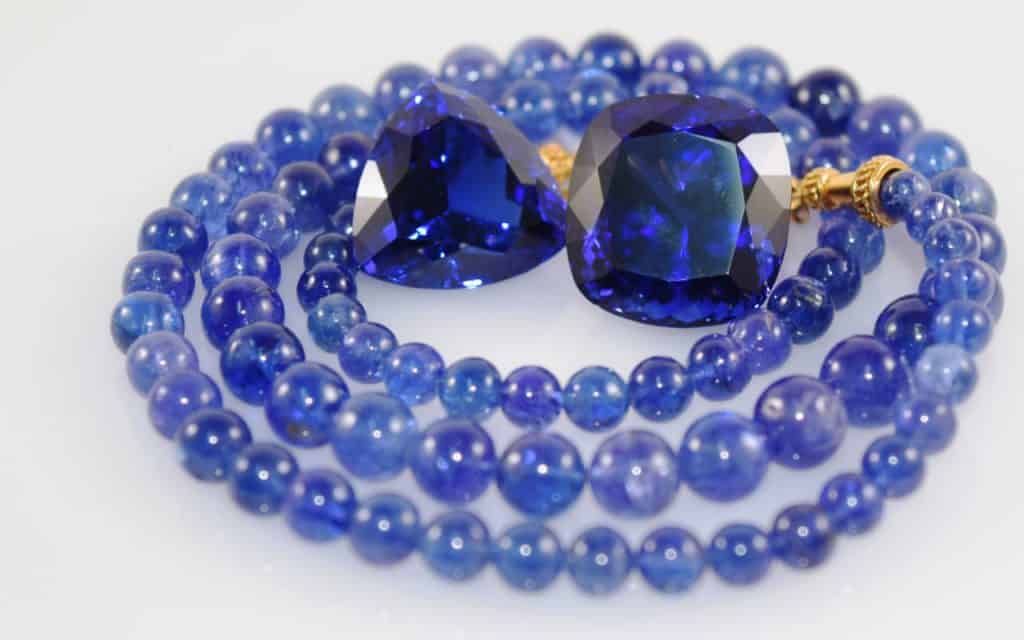
The first thing to bear in mind about the cleaning process is to never clean it using harsh chemicals. Always read the ingredients used in making the cleaning product. The safest method of cleaning your tanzanite is by using warm soapy water.
The best method for cleaning your tanzanite jewelry when it gets cloudy is to soak it for 20-30 minutes in warm soapy water. After that use a clean and soft cloth to gently rub around the stone and dry off excess water. In order to clean the band of your rings or get into small crevices make use of a Q-tip.
Ultrasonic cleaning involves the use of sound waves to break down the dirt particles on the surface of the jewelry. Most jewelers make use of these devices to wash gemstones and jewelry. You should avoid using these devices to clean your Tanzanite jewelry. The stress that these cleaners put on the stone can cause some serious damage.
Tanzanite jewelry, especially rings, is not to be worn regularly. It can be subject to wear and tear when doing house chores. However, while Tanzanite is a fairly soft gem, it can still be worn in all types of jewelry if worn with care. Harsh impacts and rough surfaces should be avoided at all costs as they might damage the shine and luster of the gemstone.
People know Tanzanite for its beauty but not the Tanzanite Mining. It poised lush blue, vibrant violet, and rich purple appearance. Unknown to a lot of people is that gemstone is more sought-after than diamond. This rare stone is only found near majestic Mount Kilimanjaro.
Legend has it that this stone first came into existence approximately 585 million years ago after the Mererani hills were set ablaze by a bolt of lightning. According to the Maasai tribesmen, the effect of the heat on the brown zoisite crystals brought about the blue color of the rare crystals. The world’s most sought-after gem was discovered by Ndugu Jumanne Ngoma in 1967.
Shortly after its discovery, Tiffany & Co found out about this new gemstone. They introduced it into the market and attributed a lovely name to it which pays tribute to the land of its birth. This gemstone is hugely sought after, and popular and is the most beautiful stone to be discovered in 2000 years.
Tanzanite mining takes time and involves a complex process. Here's how Tanzanite is mined:
Tanzanite is recovered from pegmatite veins that have become so stressed and broken down into tiny and smaller pieces called boudins. These gems are found within small pockets inside the boudins. The goal of Tanzanite mining is to find these small pockets. Not every pocket will contain the gem, some might contain minerals such as fool's gold, pyrite, and quartz.
Originally, the gemstone was collected on the surface but the continuous and vigorous Tanzanite mining quickly gave way to pits and now tunnels which are about 1000 meters beneath the surface. During the mining process, the rocks are broken into medium or small chunks using explosives such as dynamite.
Loud sounds and ground vibrations are felt from the mining site once the explosives are set off. A big boom is heard and then felt even from far distances. Once this process is done, Oxygen pipes are usually put into the mines to let in the fresh air. These pipes remove the CO2 and bring in O2. The next process involves sorting the gemstone from the raw stones.
Sorting the gemstone from the other materials can be a daunting task after the Tanzanite Mining. The gemstone can be sorted both manually and by using an automated optical sorting and primary grading system. When sorting the rough tanzanite, several steps are involved before one can achieve a gem worth selling.
The first step involves picking the gems from their shaft. Once that is achieved, the gems are taken to the sorting house where they are cleaned and weighed. The non-Gem materials are then removed from the gems, after which the gems are cobbled and graded into various groups.
Good quality gems are processed more for color, clarity, and carat grading. Once the gems have been graded and sized, they are packed and ready to be sold.
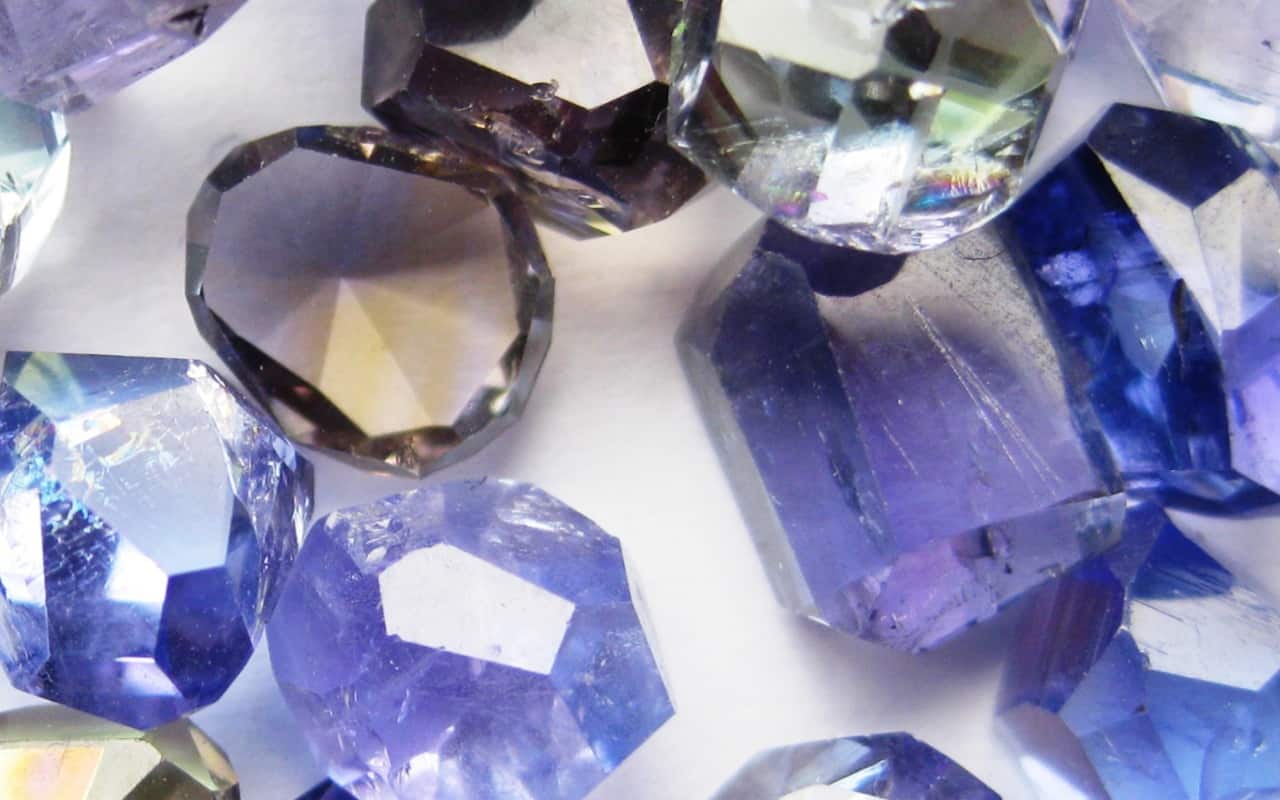
The spare Tanzanite materials are taken back to laboratories by companies. These materials are tested to see if they can be heated to become high-quality gemstones. There are also some minerals that might be found in the Tanzanite stone. Here at Tanzanite Experience, we keep these minerals on display in our museum to educate people about everything Tanzanite.

Tanzania is the world’s largest and only producer of tanzanite. These rare gem deposits are known to be confined to a few square miles of land in northern Tanzania and it is the only gemstone that has a large growing popularity and a limited known supply.
Sourcing and buying Tanzanite from trusted dealers in Tanzania helps support the country’s economy. You’ll also be getting stones and jewelry from the source, so you can be sure you’re getting the best quality Tanzanite at the best price.
Tanzanite is a variety of the mineral zoisite and its different varieties range from blue to violet, or purple in color. This gemstone is best described as a rare Precious stone’, it is 1,000 times rarer than diamonds.
Tanzanite jewelry is highly valuable and sought-after, both for the gem’s uncommonness, as well as its exquisiteness.
Ever since this rare blue gemstone Tanzanite today was first discovered in 1967, it has been admired for its truly unique beauty. The beautiful blue stone traces its way back to Tanzania, at the base of the mighty Mt. Kilimanjaro.
What most people don’t know is that ‘Tanzanite’ is a commercial name for the ‘Blue Zoisite’, coined by the very famous Tiffany and Company. Some people refer to it as the Birthstone for December, but the world recognizes it as the sparkling rare blue gemstone.
Tanzanite is a part of the Zoisite minerals family or the silicate family. The Zoisite mineral can naturally be found in many shades and hues like pink, green, blue, etc., or may even be colorless.
The Stone lies between shades of blue to a purple-bluish tinge. Although it is not as old as the other gemstones, Tanzanite has been recognized as the 2nd most admired and popular gemstone.
The popularity of this rare gemstone can be attributed to its color and the fact that a globally reputed brand like Tiffany, strongly vouched for it.
Tanzanite is a rare multi-dimensional color gemstone that reflects vibrant hues of blues and violets. What makes this one of the rarest gemstones is that the likelihood of finding tanzanite anywhere else except the Mererani Hills near Arusha (Tanzania) is almost impossible

Tanzanite comes from a legend that says that when lightning struck the foothills of the Mererani Hills, a wildfire engulfed the grasslands around the area.
Once the fire died, the local herders returned to the area and discovered what was left behind were sparkling blue stones; the rare gemstone we call Tanzanite.
It was later discovered by a Portuguese geologist who studied the stone and found out that it was a Zoisite mineral. Tiffany and Co. took over the stone and introduced it to the world.
Today, other smaller gemstone dealers are also legally mining and supplying the gemstone. However, it’s not available in very large quantities and only a hundred and fifty miners have been granted the license to mine it.
This rare blue gemstone was declared a birthstone for December by the American Gem Trade Association in 2002. It is the birthstone for the zodiac signs, Aries and Pisces. Tanzanite shares its birthstone of December status with 2 other blue gems, Turquoise and Zircon.
This rare blue gemstone has also gained a significant position in Feng Shui, signifying purity and strength. Keeping this rare blue gemstone in a room is believed to attract calmness and peace.
Its presence in the workplace is believed to relieve stress and maximize productivity. The gemstone has also found its place in the world of healing crystals, spiritual energy stones, Chakra healing stones, and also for physical healing.

Tanzanite is mined and found in a very small region that is spread across just 4 km in width and 2 km in length.
After the stone was discovered in 1967, approximately 2 million carats of the rare blue gemstone were mined in Tanzania. These mines were then nationalized by the government of Tanzania in 1971. There is only a limited resource and thus a streamlined mining process had to be put in place.
In 1990, the government of Tanzania divided the mining area into 4 categories namely Blocks A, B, C, and D. The blocks were divided between the large operators and the local miners. For instance, The Tanzanite Experience has its mine located in Block D.
However, the rapid pace at which the gemstone is being mined may soon lead to the depletion of the gemstone and complete exhaustion of the supply. It is thus also referred to as the “gemstone of a generation”.

Tanzanite is not the only blue gemstone, but is considered unique and exclusive because of its very rare ‘blue’. The range of blue tones that the Tanzanite stone offers is unique to it and sometimes a violet or purple tinge may also be seen.
In comparison to other minerals, like Diamond or Sapphire, Tanzanite stands out. Although Sapphire is still the most popular blue gemstone, Tanzanite is second. Another reason that may have enhanced the gemstone’s popularity is that it is equally, and sometimes more beautiful, than Sapphire, yet costs much lesser.
Additionally, Tanzanite is an all-naturally created gemstone, as compared to the widely available Sapphire created in a lab. The raw, natural, and authenticity of the gemstone make it more attractive.
In comparison to a Diamond, Tanzanite is much cheaper and more ‘modern’. Original diamonds are extremely expensive and what you may pay for a tiny diamond could bring you a much larger Tanzanite.
While a diamond will always be considered a ‘classic’ and ‘timeless’ gemstone, Tanzanite has a raw and very new look to it. The color, here again, makes it a popular choice.

A wide range of Chemical and Physical Tanzanite properties have been extensively studied by geologists and researchers. Let’s discuss the 3 most distinct properties:
It is the color of this blue gemstone that is most distinctly unique to it. Although considered a rare blue gemstone, it is actually a Pleochroic gem. Pleochroism is a physical property that allows the gemstone to appear to be a different color when viewed from different directions.
A single piece of this gemstone can appear blue, violet, or even red, depending on which direction we are looking from. Some can display 2, 3, or even more different shades from different directions.
A brilliant blue remains the most sought-after color of Tanzanite and also yields the highest value. Cutting the gemstone thus requires extreme skills to ensure that the blue color is maximized.
Tanzanite is a rare blue gemstone that looks beautiful in jewelry. However, the use of tanzanite must be restricted to jewelry that is worn on special occasions or ones that do not go under heavy abrasion or impact. Thus, earrings and pendants are preferred over rings.
The durability of a gemstone is measured in terms of hardness, or its scratch resistance. Tanzanite properties in terms of durability or hardness are about 6.5 on, which is low for daily wear as it may easily get scratched. However, the design of the ring, if made in such a way that the stone does not receive any direct pressure or impact, will increase its durability.
The other measure of durability is toughness or breakage resistance. Every stone has at least one direction, which is directly impacted and may lead to a break or chipping. However, as mentioned earlier, the design plays an important role in ascertaining the direct impact on the stone.
The stone is also sensitive to extreme changes in temperature and may break as a result too. Our Tanzanite buying guide delves deeper into this concept. Taking caution while wearing this blue gemstone is thus required.
The third measure of durability is color stability. Tanzanite scores well on this scale. However, like most gemstones, you must keep them away from acids or chemicals as they damage the stone. Tanzanite stones that have been heated and treated are more stable and are not affected by normal exposure to light or daily temperature changes.
Like most gemstones finding smaller tanzanite stones are much easier as they are available in abundance. The same can't be said about the large pieces. Most available stones are around 5 carats, stones that are more than 50 carats are very rare.
The smaller stones are usually cut for commercial jewelry. On the other hand, stones that have a very distinct coloring are usually used for designer jewelry.
Big Tanzanite stones that have a valuable distinct color are often bought by collectors, investors, or even museums. In fact, the size of the Tanzanite also directly affects the color; the larger the stone, the larger the distance the light travels through it. Larger Tanzanite stones thus display a richer blue color.
Heat treatment is common practice for almost all tanzanite stones available in the market for commercial buying and selling. The heat treatment enhances the color or sometimes produces the rare blue color the gemstone is well known for. However, naturally blue-colored Tanzanite stones can also be found with miners. Some buyers prefer the non-treated tanzanite to the heat-treated one.
Tanzanite found in the markets, in jewelry settings, and otherwise, are all usually heat treated; and most customers and retailers prefer the heat treated Tanzanite for the improved color.
A common question that both retailers and customers of rare gemstones have is, is it real or fake? It’s no secret that fake gemstones are as easily available as real ones. So how can retailers and customers ascertain whether or not a tanzanite stone is real or fake?
When it comes to tanzanite, many people sell Forsterite instead, a mineral that can be produced in the color and with similar properties as the Tanzanite stone. Corantine is another blue synthetic stone that may be mistaken for Tanzanite.
When Buying Tanzanite, buyers must consider the 4 C’s that ascertain the quality, these are:
This includes hue and saturation. Tanzanite is very rarely only blue and usually has a tinge of violet. The stone color is always checked as a combination of both colors.
vB or violetish blue is used to denote Tanzanite which has 50% blue under white light. On the other hand, bV or bluish violet is used for one that is majorly violet.
This includes the inclusions or the presence of any natural flaws within the stone. It ranges from lowest to highest- Heavily Included (HI), Moderately Included (MI), Slightly Included (SI), and Eye Clean (EC).
This includes the finish, proportion, shape, and brilliance of the stone. These cuts are categorized as Too Deep, Too Shallow, or Well Cut.
Refers to the weight of the gemstone. 1 carat is 1/5 of a gram and has 100 points. The depth of the stone also changes the carat weight, even though the stones may be identical.
If you are planning to buy Tanzanite, the beautiful rare blue gemstone, to add to your valuable possessions, it is important you deal with only reputable Tanzanite dealers who offer genuine goods. As discussed earlier, there are a lot of retailers selling fake Tanzanite, under the guise of being real, so if you are not too sure about how to test the quality, the safest bet is to buy Tanzanite from legal, trusted retailers such as Tanzanite Experience.
While you’re at it visit their museum, it's one of the many attractions in Arusha. In the museum, you get to learn more about this beautiful blue gemstone.
Tanzanite is one of the most unique and desirable gemstones currently known around the world. Its rarity and preciousness can be directly linked to the exclusivity of its source. These deep blue-violet gems can only be found in the foothills of Mount Kilimanjaro. Tanzanite, thus, acquired its name as a symbol of pride for its country of origin, Tanzania.
There are a few mining bases located around the Mererani hills at the foot of the mountain in the city of Arusha. According to experts, the current supply of gemstones has decreased significantly over the years. This unique stone will be a rare commodity in the next 25 to 30 years making it “the gemstone of the generation”.
There is a high chance that this will be the last generation to mine, wear and buy first-hand Tanzanite gemstones before the supply runs out. The gemstone’s limited scarcity has made it a thousand times rarer than diamonds, making it all the more special.
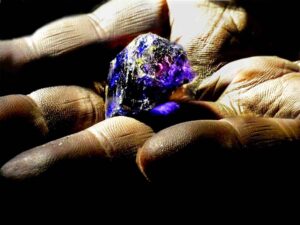
In 1967, a Maasai herder came across the gemstones while walking near the foot of Mount Kilimanjaro. He initially thought he had stumbled upon colorful sapphires, these stones were later confirmed to be a new variety of gemstones. New York’s celebrated jewelers Tiffany & Co. popularized the new gemstone about a year after its discovery and coined its new name Tanzanite as a token of its heritage.
The majority of the world’s most popular gemstones have been discovered and put to use for hundreds of years. Tanzanite, on the other hand, came into the limelight only a few years ago. Despite being formed about 585 million years ago, the gem was not unearthed and used in commercial quantities until the early 1960s.
Tanzanite is trichroic in nature, which means that it can radiate different colors when positioned at different angles. For instance, under the midday sun, it radiates a deep blue hue while later on in the course of the day, it will radiate different colors from intense violet to pale lavender and sky blue. These colors include blue, purple, and red all of which combined give it a vibrant indigo color.
Occasionally people can buy Tanzanite jewelry that is green or pink in color. However, the majority of Tanzanite jewelry being sold today are of a blue color. The blue of the Tanzanite is caused by small amounts of vanadium within its zoisite mineral structure.
The heat treatment that Tanzanite jewelry undergoes is very mild in comparison to the processes for other stones including sapphires and rubies. The world’s only Tanzanite Museum at the Tanzanite Experience will offer you a close-up view of the magical Tanzanite gemstones, and their process from the raw stone to the mesmerizing gem.
Aside from their vibrant color, Tanzanite gemstones are extremely durable which is why they are sold as earrings, pendants, and other jewelry items. They are resistant to impact and abrasions and can last for multiple generations. They come in different sizes. The small stones are cut for sale and larger stones are showcased in showrooms to be purchased by collectors and investors.
At the scenic foothills of Mount Kilimanjaro lie the Merelani Hills, the only place in the entire world where Tanzanite is found. It is only in this mythical place, that the Tanzanite stone was first discovered and unearthed. The area of the Tanzanite mines spans only 14 square kilometers along the hills.
The groundwork for the grand entrance of Tanzanite into this world began 585 million years ago with the continental shifts that created Mount Kilimanjaro and the Great Rift Valley.
During this process, the collision of the tectonic plates caused their different minerals to morph together under intense heat and pressure to create elongated pods known as ‘boudins’ which are the sediments that bear the unique Tanzanite today.
This natural process of the heating and compression of those specific minerals explains the formation of this unique source of crystal structures that form the Tanzanite gem.
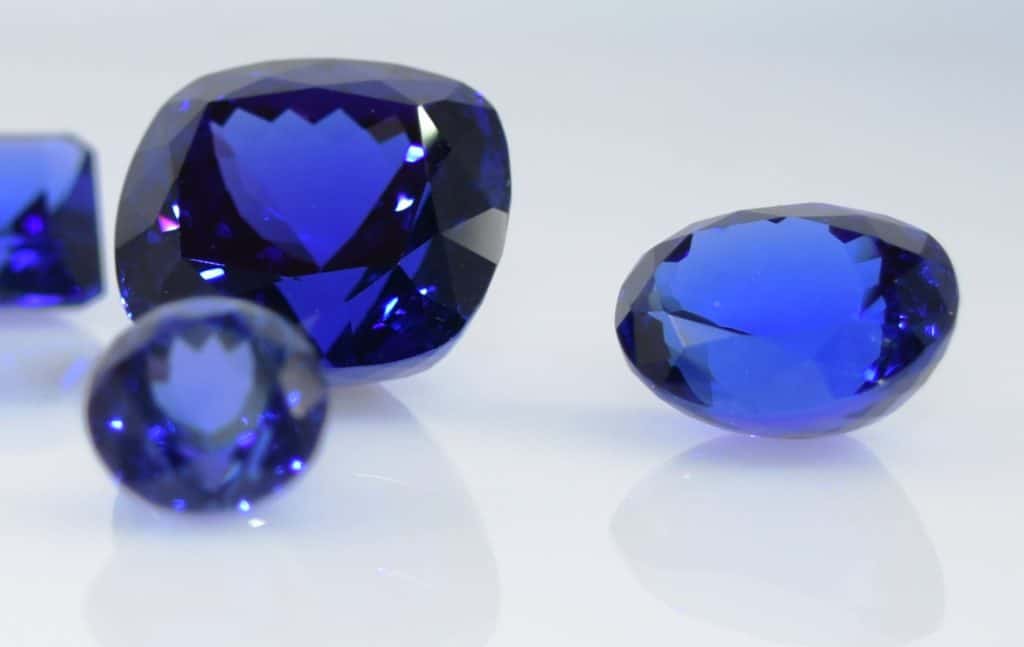
The circumstances that led to the formation of Tanzanites were so exceptional that it’s hardly likely to find this gem occurring naturally anywhere else in the world. After all, it took the birth of a natural monument as impressive as Mount Kilimanjaro to craft the Tanzanite stone. This makes it a thousand times rarer than a diamond.

Tanzanite is also very limited in supply. It is estimated that the world will run out of its Tanzanite stockpile within the next two decades or so. Tanzanite is thus known as the “gemstone of the generation” after the short but memorable lifespan of its source. The vibrant trichroic stones will no longer be available for purchase from the primary market.
Tanzanite is as rare as it is beautiful. Seize this opportunity and get you or your loved one, this gift of a lifetime. A reputable Tanzanite dealer can get you jewelry and gemstones of high quality. In addition, a certificate of authenticity will also be provided with the purchase. Read more about this in the Tanzanite buying guide. It is very important that you exercise caution when looking to purchase this rare gemstone and deal solely with experts and professionals.